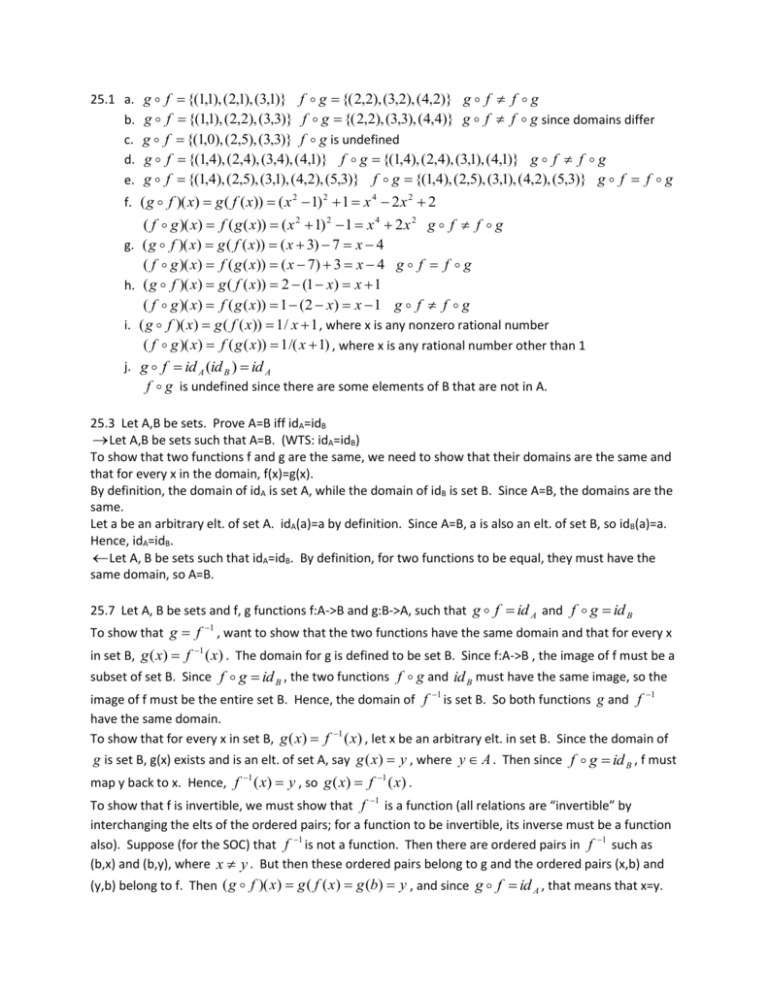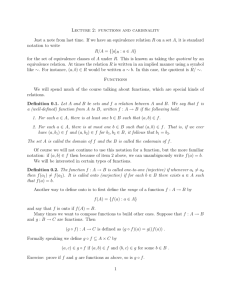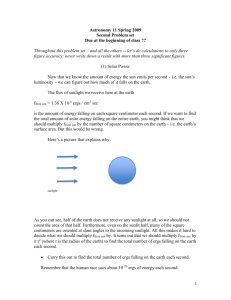File
advertisement

25.1 a.
b.
c.
d.
e.
g f
g f
g f
g f
g f
{(1,1), (2,1), (3,1)} f g {( 2,2), (3,2), (4,2)} g f f g
{(1,1), (2,2), (3,3)} f g {( 2,2), (3,3), (4,4)} g f f g since domains differ
{(1,0), (2,5), (3,3)} f g is undefined
{(1,4), (2,4), (3,4), (4,1)} f g {(1,4), (2,4), (3,1), (4,1)} g f f g
{(1,4), (2,5), (3,1), (4,2), (5,3)} f g {(1,4), (2,5), (3,1), (4,2), (5,3)} g f f g
f. ( g f )( x) g ( f ( x)) ( x 2 1) 2 1 x 4 2 x 2 2
( f g )( x) f ( g ( x)) ( x 2 1) 2 1 x 4 2 x 2 g f f g
g. ( g f )( x) g ( f ( x)) ( x 3) 7 x 4
( f g )( x) f ( g ( x)) ( x 7) 3 x 4 g f f g
h. ( g f )( x) g ( f ( x)) 2 (1 x) x 1
( f g )( x) f ( g ( x)) 1 (2 x) x 1 g f f g
i. ( g f )( x) g ( f ( x)) 1 / x 1 , where x is any nonzero rational number
( f g )( x) f ( g ( x)) 1 /( x 1) , where x is any rational number other than 1
j. g f id A (id B ) id A
f g is undefined since there are some elements of B that are not in A.
25.3 Let A,B be sets. Prove A=B iff idA=idB
Let A,B be sets such that A=B. (WTS: idA=idB)
To show that two functions f and g are the same, we need to show that their domains are the same and
that for every x in the domain, f(x)=g(x).
By definition, the domain of idA is set A, while the domain of idB is set B. Since A=B, the domains are the
same.
Let a be an arbitrary elt. of set A. idA(a)=a by definition. Since A=B, a is also an elt. of set B, so idB(a)=a.
Hence, idA=idB.
Let A, B be sets such that idA=idB. By definition, for two functions to be equal, they must have the
same domain, so A=B.
25.7 Let A, B be sets and f, g functions f:A->B and g:B->A, such that g f id A and f g id B
To show that g f
in set B, g ( x) f
1
, want to show that the two functions have the same domain and that for every x
1
( x) . The domain for g is defined to be set B. Since f:A->B , the image of f must be a
subset of set B. Since f g id B , the two functions f g and id B must have the same image, so the
image of f must be the entire set B. Hence, the domain of f 1 is set B. So both functions g and f 1
have the same domain.
To show that for every x in set B, g ( x) f
1
( x) , let x be an arbitrary elt. in set B. Since the domain of
g is set B, g(x) exists and is an elt. of set A, say g ( x) y , where y A . Then since f g id B , f must
map y back to x. Hence, f
1
( x) y , so g ( x) f 1 ( x) .
To show that f is invertible, we must show that f 1 is a function (all relations are “invertible” by
interchanging the elts of the ordered pairs; for a function to be invertible, its inverse must be a function
also). Suppose (for the SOC) that f 1 is not a function. Then there are ordered pairs in f 1 such as
(b,x) and (b,y), where x y . But then these ordered pairs belong to g and the ordered pairs (x,b) and
(y,b) belong to f. Then ( g f )( x) g ( f ( x) g (b) y , and since g f id A , that means that x=y.
This results in a contradiction, so f
direct proof also)
1
must be a function. (Note: this proof could have been written as a
25.8 f : A B bijection. The domain of f f
1
is set B, but the domain of idA is set A.
25.9 a. Let x, y A, x y .
Since f is 1-1, f ( x) f ( y ) .
Since g is 1-1, g ( f ( x)) g ( f ( y ))
Hence, g f is 1-1.
b. Let c C . Since g is onto, b B such that g(b)=c. Since f is onto, a A such that f(a)=b.
hence, ( g f )( a) g ( f (a)) g (b) c . So g f is onto.
c. a+b->c
25.11 No to both a and b. A is not a finite set (see 23.12).
25.12 a. Was proven to be true in 25.9
b. false. Let A={1,2,3}
Let f={(1,2),(2,1),(3,3)} Then f-1={(2,1),(1,2),(3,3)}
Let g=((1,3),(2,2),(3,1)} Then g-1={(3,1),(2,2),(1,3)}
g f {(1,2), (2,3), (3,1)} so ( g f ) 1 {( 2,1), (3,2), (1,3)}
But g 1 f
1
{(1,2), (2,3), (3,1)} So ( g f ) 1 g 1 f 1
c. True. Prove: ( g f ) 1 f 1 g 1
Let f:A->A and g:A->A be bijections.
According to the result of 25.7, if we can show that:
(1) ( g f ) ( f 1 g 1 ) id A and
(2) ( f 1 g 1 ) ( g f ) id A , then we will have shown that ( g f ) 1 f 1 g 1 .
To show that (1) is true, we want to show that the functions on both sides have the same
domain and that for every x in A, each function maps x to the same value.
The domain of idA is A by definition. The domain of the composite function
( g f ) ( f 1 g 1 ) is the same as the domain of g 1 , which is the right-most function. Since
g is a bijection from A to A, the domain of g 1 is A, and hence the domain of
( g f ) ( f 1 g 1 ) is A also. So the two functions have the same domain.
To show that they both map the elt. x in set A to the same value:
IdA(x)=x by definition.
Since g is a bijection from A to A, there is a unique elt. in set A, say y, such that g(y)=x. Then
g-1(x)=y. Since f is a bijection from A to A, there is a unique elt. in set A, say z, such that f(z)=y.
Then f-1(y)=z, so ( g f )( z ) g ( f ( z )) g ( y ) x , and hence, ( g f ) ( f 1 g 1 )( x) x
So the two functions are equal, ( g f ) ( f
The proof of (2) is very similar…
1
g 1 ) id A .











